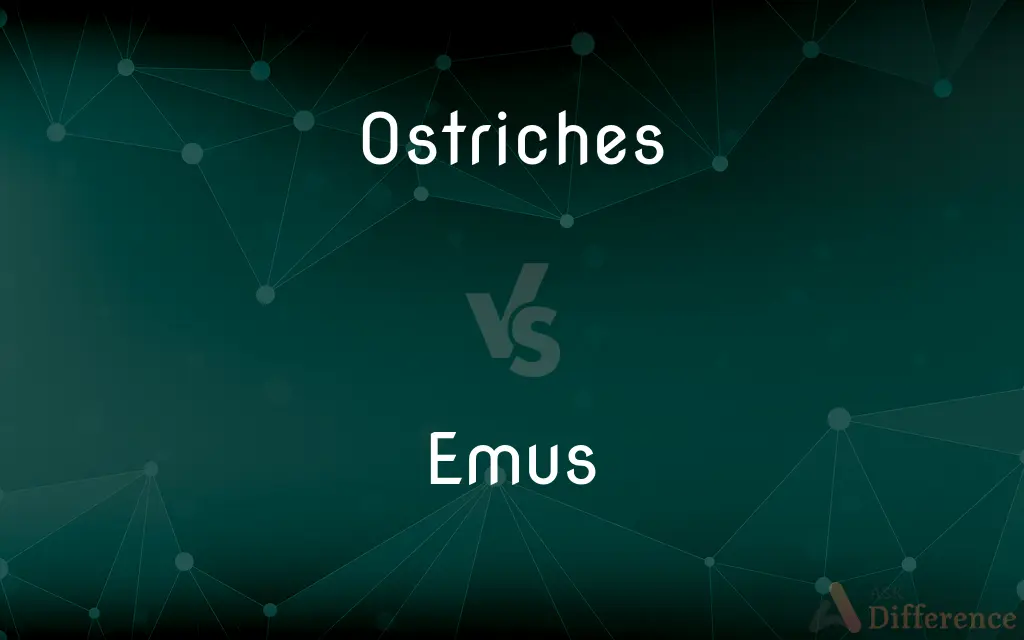Ostriches vs. Emus — What's the Difference?
By Tayyaba Rehman — Published on December 11, 2023
Ostriches are the world's largest flightless birds from Africa with two toes, while Emus are Australia's native flightless birds with three toes. Both are known for their speed and inability to fly.

Difference Between Ostriches and Emus
Table of Contents
ADVERTISEMENT
Key Differences
Ostriches and Emus, while similar in many respects, are distinct species of flightless birds. Ostriches are native to Africa and are recognized as the world's largest birds, whereas Emus hail from Australia and rank as the world's second-largest birds.
When observing their physical characteristics, Ostriches possess long necks and legs, enabling them to run at impressive speeds. In contrast, Emus exhibit a more stout physique but still manage to be swift runners.
Additionally, Ostriches have two toes on each foot, which aids in their rapid locomotion; Emus, however, have three toes, which provide added stability on diverse terrains.
Regarding their habitats, Ostriches tend to thrive in a variety of African landscapes, from savannas to deserts. On the other hand, Emus are versatile birds that inhabit a range of environments in Australia, from forests to plains.
Comparison Chart
Native Region
Africa
Australia
ADVERTISEMENT
Size
World's largest bird
World's second-largest bird
Number of Toes
Two toes on each foot
Three toes on each foot
Color
Black and white feathers (males)
Brown feathers
Eggs
Large with thick, glossy shells
Dark green-blue with a matte finish
Compare with Definitions
Ostriches
Herbivores that occasionally consume insects.
While primarily eating plants, Ostriches will also snack on locusts and other insects.
Emus
Flightless birds indigenous to Australia.
Emus are a common sight in many parts of the Australian outback.
Ostriches
Birds recognized for their impressive speed on land.
Even without the ability to fly, Ostriches can evade many predators with their quickness.
Emus
Creatures that can run rapidly despite their weight.
Emus might appear cumbersome, but they can outrun many threats.
Ostriches
Large, flightless birds native to Africa.
The Ostriches raced across the savanna, their long legs carrying them swiftly.
Emus
Birds known for their brown plumage and stout build.
The Emus' brown feathers allow them to blend seamlessly with the Australian landscapes.
Ostriches
Creatures with a distinct appearance, characterized by long necks and legs.
Ostriches can be easily distinguished from other birds due to their towering stature.
Emus
Birds that lay dark green-blue eggs.
Emus' eggs are unique, boasting a rich hue and matte texture.
Ostriches
Birds that lay notably large eggs with tough shells.
Ostriches' eggs are coveted by many due to their size and nutritious value.
Emus
Omnivores that primarily feed on plants, seeds, and insects.
Emus have a diverse diet, including fruits, flowers, and small creatures.
Ostriches
Either of two large, swift-running flightless birds (Struthio camelus or S. molybdophanes) of Africa, characterized by a long bare neck, small head, and two-toed feet. Ostriches are the largest living birds.
Emus
A large, flightless Australian bird (Dromaius novaehollandiae) that has shaggy brown plumage and is raised for its meat, oil, and leather.
Ostriches
A rhea.
Emus
Plural of emu
Ostriches
One who tries to avoid disagreeable situations by refusing to face them.
Ostriches
Plural of ostrich
Common Curiosities
Where are Ostriches and Emus originally from?
Ostriches are native to Africa, while Emus are indigenous to Australia.
What do Ostriches and Emus primarily eat?
Ostriches mainly consume plants and occasionally insects, while Emus eat plants, seeds, and insects.
Are the feathers of Ostriches and Emus similar?
While both have soft, hair-like feathers, Ostriches often have black and white plumage, whereas Emus have brown feathers.
How fast can Ostriches and Emus run?
Ostriches can reach speeds of up to 45 mph, while Emus can run at speeds up to 30 mph.
Which is larger, Ostriches or Emus?
Ostriches are the world's largest birds, making them larger than Emus.
Do Ostriches and Emus have similar social behaviors?
Both birds can be seen in groups, but their social structures and behaviors can differ.
Can both Ostriches and Emus fly?
No, both Ostriches and Emus are flightless birds.
Do Ostriches and Emus have similar lifespans?
Ostriches can live up to 40-45 years, whereas Emus typically have a lifespan of 10-20 years.
How do Ostriches and Emus protect themselves from predators?
Both use their strong legs for running away from threats, and they can deliver powerful kicks if cornered.
How do Ostriches and Emus adapt to hot climates?
Both birds can tolerate high temperatures and have physiological adaptations, like large nasal passages, to cool the blood.
How many eggs do Ostriches and Emus typically lay?
Ostriches can lay 40-60 eggs annually, while Emus lay around 8-10 eggs in a season.
Which bird has a more powerful kick, Ostriches or Emus?
Both can deliver potent kicks, but given the Ostrich's size, its kick is often deemed more forceful.
What colors are the eggs of Ostriches and Emus?
Ostriches lay eggs with a glossy finish, while Emus' eggs have a dark green-blue hue with a matte finish.
Are there any conservation concerns for Ostriches and Emus?
Ostrich populations are stable, but some Emu populations, especially in specific habitats, face threats due to habitat loss.
Are Ostriches and Emus kept on farms?
Yes, both are farmed for various reasons, including meat, feathers, and eggs.
Share Your Discovery

Previous Comparison
Grains vs. Cereals
Next Comparison
Nuts vs. BoltsAuthor Spotlight
Written by
Tayyaba RehmanTayyaba Rehman is a distinguished writer, currently serving as a primary contributor to askdifference.com. As a researcher in semantics and etymology, Tayyaba's passion for the complexity of languages and their distinctions has found a perfect home on the platform. Tayyaba delves into the intricacies of language, distinguishing between commonly confused words and phrases, thereby providing clarity for readers worldwide.
















































